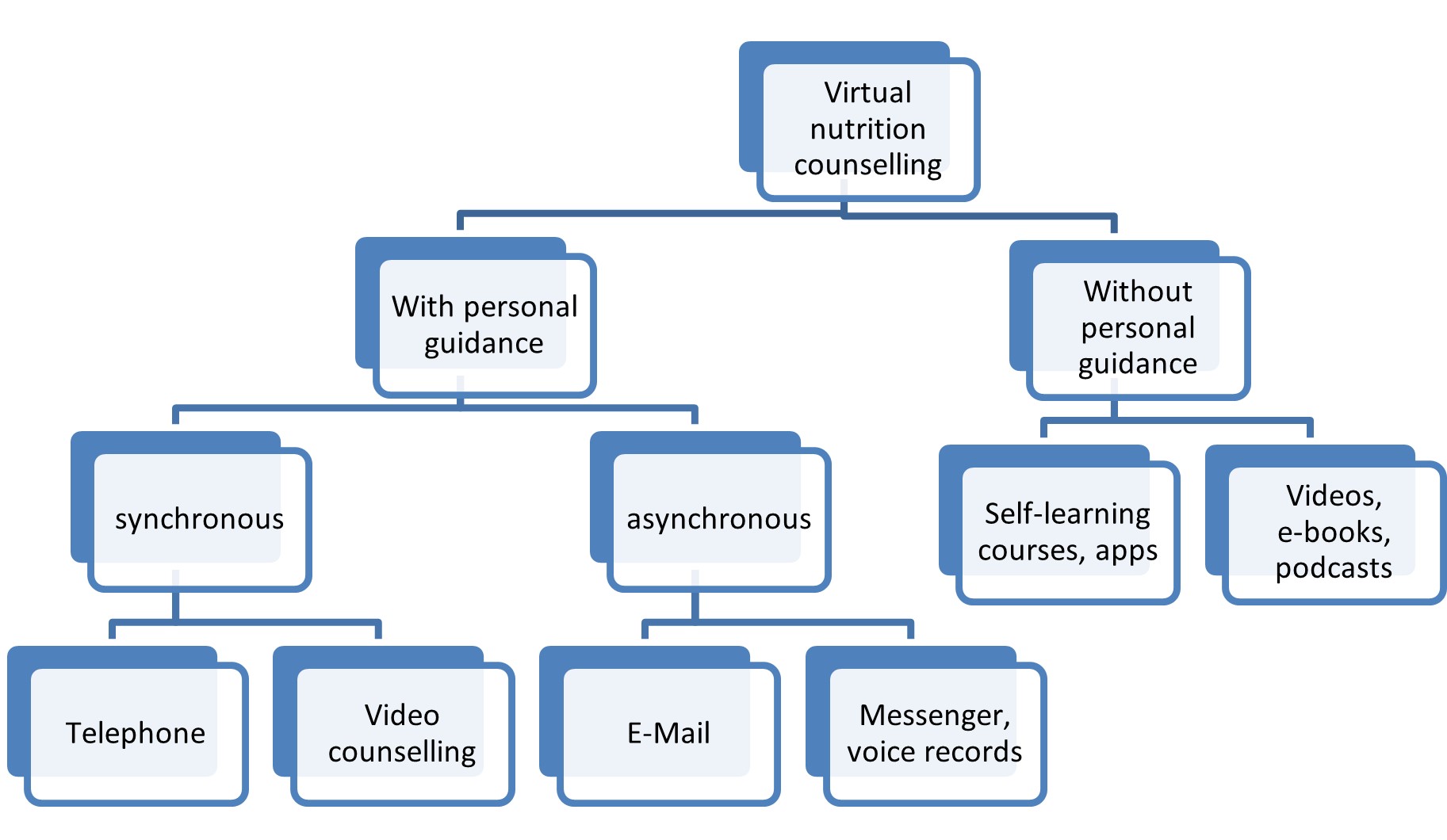The design of a handbook for dietetics educators on the needed competencies and training of dieticians in virtual nutrition counselling
Aim and Research Question(s)
The aim of this work was to determine which competencies dieticians need when conducting virtual nutrition counselling and how dietetics educators should design a course on virtual nutrition counselling.
Background
Since the onset of the Covid 19 pandemic and the resulting measures such as social distancing, the importance and use of virtual nutrition counselling have increased dramatically. Video consultations have increased tenfold in the USA due to the Corona pandemic. Dieticians had to switch from face-to-face consultations to virtual nutrition counselling. (Farid, 2020) In virtual nutrition counselling, the counselling/communication does not occur face-to-face. Instead, it takes place remotely via digital media, such as computers or smartphones (Götz, 2020). Figure 1 Types of virtual nutrition counselling, adapted from (Götz, 2020).
To ensure the effective use of virtual nutrition counselling, training on using the technologies is essential (Rollo, Collins, & MacDonald-Wicks, 2017).
Figure 1 Types of virtual nutrition counselling, adapted from (Götz, 2020).
To ensure the effective use of virtual nutrition counselling, training on using the technologies is essential (Rollo, Collins, & MacDonald-Wicks, 2017).
Methods
A group survey was conducted in the sense of a design thinking workshop. Dieticians, dietetics students, dietetics educators and people with health concerns participated in the workshop. The collected data were analysed qualitatively by using inductive, summarising qualitative content analysis according to Mayring.
Results and Discussion
The data collection showed that in addition to the ability to communicate using digital technologies, dieticians need to know about the different uses, benefits and functions of the different digital communication methods. Furthermore, dieticians need the ability to support patients in case of technical difficulties. The evaluation of the workshop showed that dieticians need to develop skills and abilities for virtual nutrition counselling to compensate for the lower perception of gestures and facial expressions. Therefore, specific questioning techniques to determine whether the patient understands the therapist and vice versa play an even more important role in the digital setting than in face-to-face counselling.
Conclusion
Based on the results of the research work, a handbook was created. The handbook is intended to support dietetics educators in planning and designing courses on virtual nutrition counselling. The handbook contains general information on virtual nutrition counselling, which competencies dieticians need to implement, and how teaching content should be designed to strengthen students' digital competence. In order to find out whether the handbook meets the needs of dietetics teachers, a usability test of the handbook could be carried out in which the educators plan a course with the help of the handbook.
References
1. Farid, D. (2020). Covid-19 and Telenutrition: Remote Consultation in Clinical Nutrition Practice. Current Developments in Nutrition, 4(12), nzaa124. 2. Götz, M. (2020). Professionelle digitale Ernährungsberatung: Anforderungen und Einsatzmöglichkeiten verschiedener Formate und Methoden. Ernährungs Umschau. (6), 336–343. 3. Rollo, M. E., Collins, C. E., & MacDonald-Wicks, L. (2017). Evaluation of the Introduction of an e-Health Skills Component for Dietetics Students. Telemedicine Journal and E-Health : The Official Journal of the American Telemedicine Association, 23(11), 930–933.